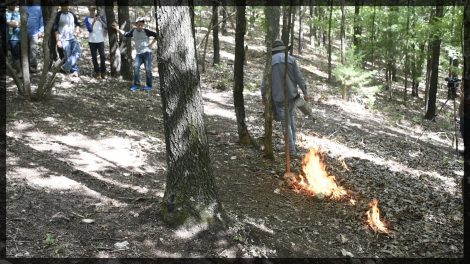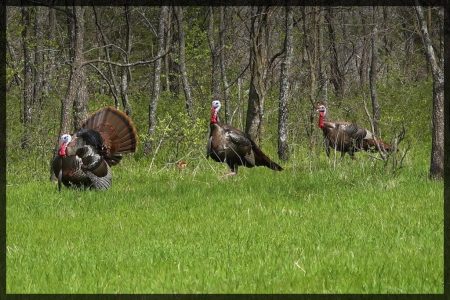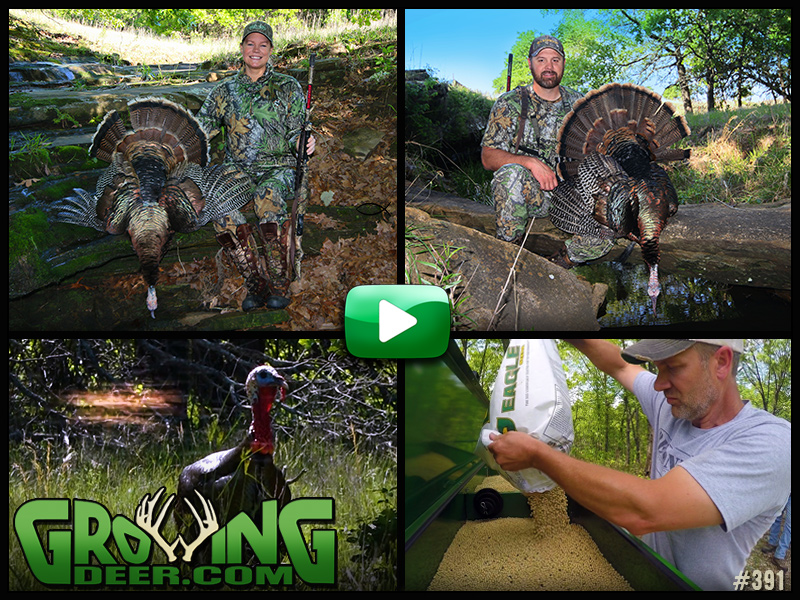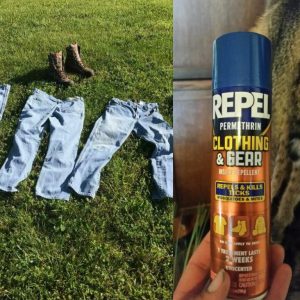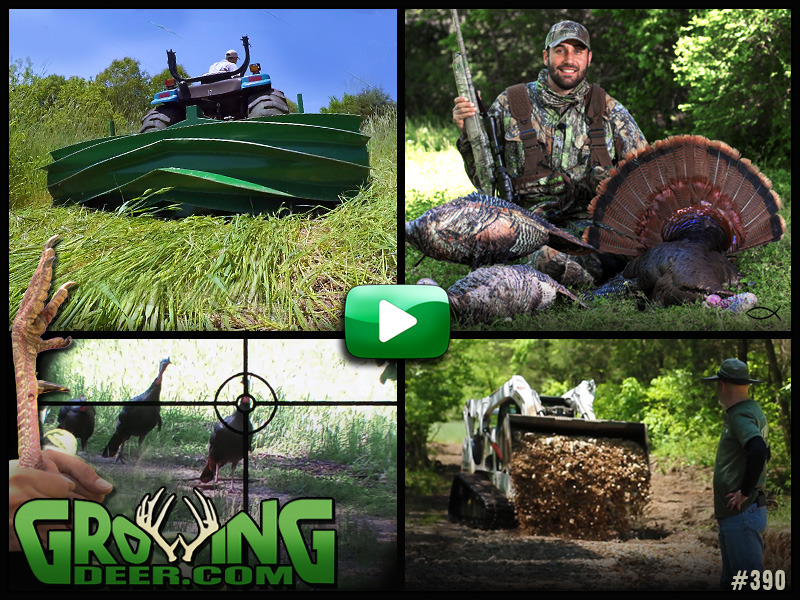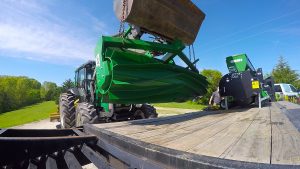Category: Turkey Hunting
Turkey Hunting Strategies: My Favorite Decoy Setups
I’ve recently shared tips from world champion turkey callers that will help us all become better at turkey calling and hunting this season. Becoming a proficient caller is the first key to get a tom to close the distance.
Once that tom has responded to the call it’s not uncommon for him to “hang up”. I’ve found that turkey decoys are an effective tool to encourage a tom to close the gap. (We use Montanna Decoys.)
My decoy setups are chosen based on the different hunting situations. These are things like the local terrain, where the birds are in the breeding season and the habitat. Below are several decoying strategies I use.
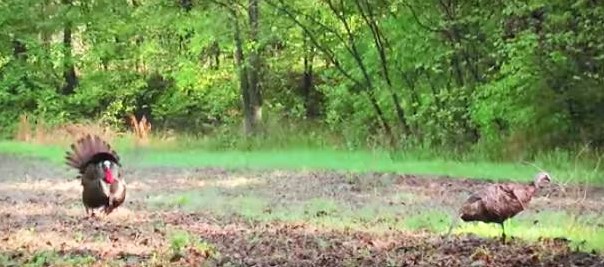
Lone Hen: My initial “go to” when I am turkey hunting is the lone hen. A lone hen has proven to be very effective in catching the attention of a gobbler. (The Miss Purr-fect by Montanna Decoys is the ideal decoy for the lone hen strategy.)
Jake/Hen combo: A jake decoy with a hen can be a strong attractant to a dominant tom. I use this combo frequently at the beginning of the hunting season when the toms are sorting out their dominance. I position the jake about two to three feet away from the hen then put the head up so that red head draws the attention of the dominant gobbler. It’s a good idea to put the lone hen in a feeder pose to create a more natural and enticing setup. Think about it: if both are upright and alert they are sending communicating that something has them nervous. As the season progresses, this remains an effective setup. As the days go on, hens leave and go sit on the nest. When it appears that a jake still has a hen with him it can make a boss tom jealous and get him fired up to come into range! One of my favorites is having a jake sit right behind a hen when she’s in the breeding pose.
Breeder Hen/Full Strut Tom: When toms are running together and working to sort out who’s the boss, another effective decoy strategy is to put a hen decoy in a breeding position in combination with a strutting tom. I set the Miss Purr-fect hen decoy on the ground (without a stake) in a breeder pose, then add a Papa Strut behind her. The local toms will see the “intruder” and come in to see who’s messing with their hen!
Three Hens: Setting up three hens is an almost irresistible setup for a tom. It’s especially effective if you’re hunting an area with bully jakes and gobblers won’t come in. But what gobbler is not coming in to three hens? When you stake out the hens, put one in the breeding pose, another in a feeding pose and another in an alert pose.
I mentioned above that we use Montana Decoys. These are easy to carry, multiple decoys can fit into your vest and they are very versatile. The days of lugging a bagful of hard, loud decoys are over! They just fold up to fit in your vest; they are adjustable and have different leg pole sleeves to enhance various poses. Think about the message you want to send when posing the heads of the decoys and add movement by using their Motion Stake.
We’ve used all these setups at different times and in different states. Each one has proven successful during the right conditions. When scouting and then during the hunt, read the mood of the turkeys and create your decoy strategy around those observations.
For more details on how to setup your decoys, click here to get a free guide from Montanna Decoy.
Chasing turkeys, setting up decoys and enjoying Creation,
Grant
Hunting Strategies, Food Plots, Turkey Calling and More! – Episode #436
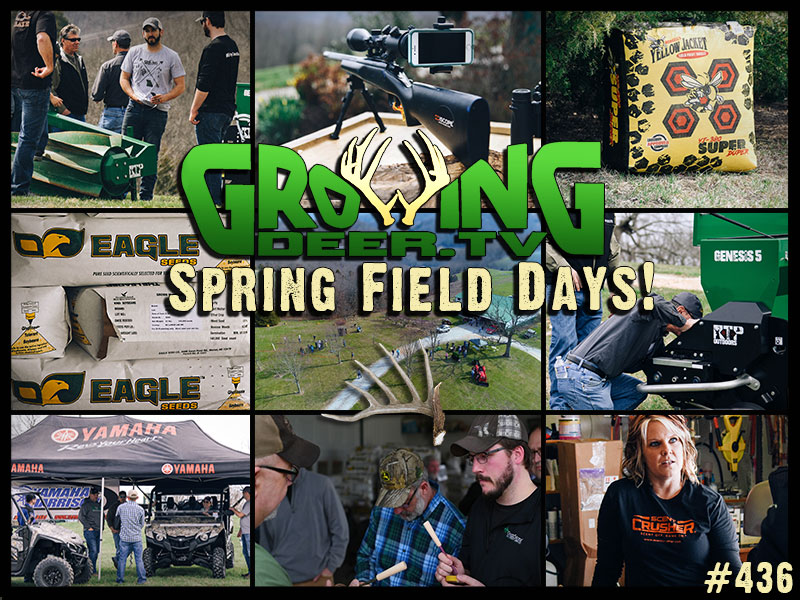 New Video
New Video
We recently held our annual Field Days at The Proving Grounds. Follow along as we share our management and hunting techniques with fellow landowners and hunters! Get an inside look and see the fun we had along the way!
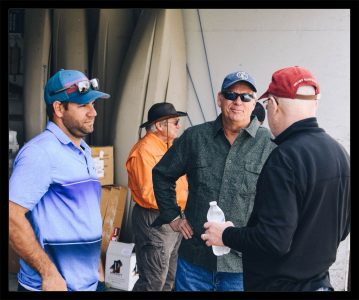 New blog:
New blog:
There were so many kind, friendly folks here at the Field Event: 128 folks from Georgia to New York to Michigan to Texas. Each and every one of them were passionate about deer hunting and deer management. Here are a few of the folks and just a little insight into why they came.
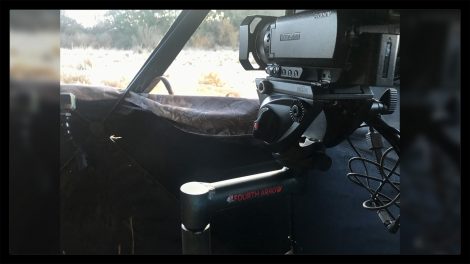 Turkey filming tips:
Turkey filming tips:
Learn tips on how to film a quality turkey hunt that you can share with your family and friends!
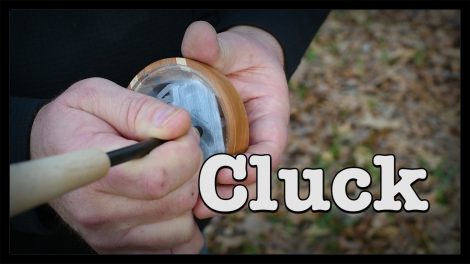 Short VIDEO:
Short VIDEO:
Here’s a video to watch and listen to over and over! Watch World Champion Friction Turkey Caller Steve Morgenstern as he shows how to call turkeys. Listen, practice and learn!
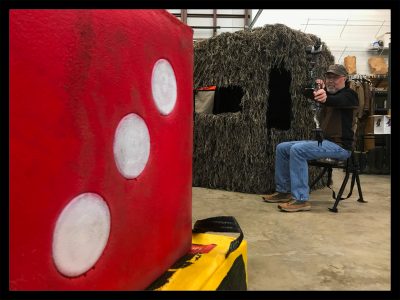
Tip of the Week:
Turkeys can get very close and that means you may need to use your 30 or 40 yard pin to hit the target. Practice close shots to prepare for turkey season.
Fired Up! Turkey Calling Tips and Strategies – Episode #435
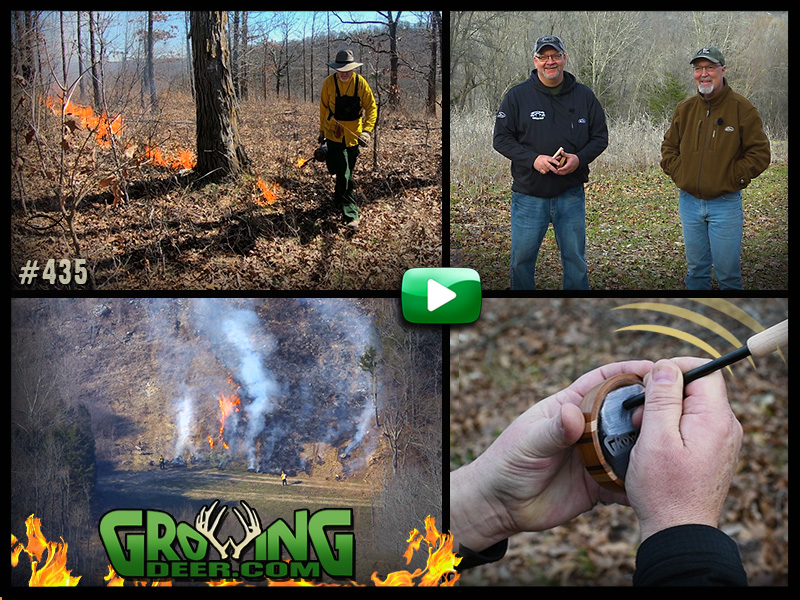 New Video
New Video
Fire conditions have been good and we continue to burn! Watch as the GrowingDeer Team plans and executes a successful prescribed fire of a bedding area. Then, pull out your turkey calls and follow along: world champion caller Steve Morgenstern stops by to share calling and turkey hunting tips!
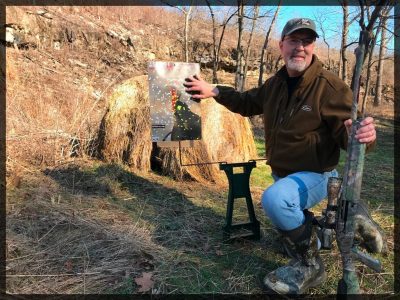 New weekly blog:
New weekly blog:
Have you patterned your turkey gun yet? We share 7 tips to remember while patterning your gun before opening day.
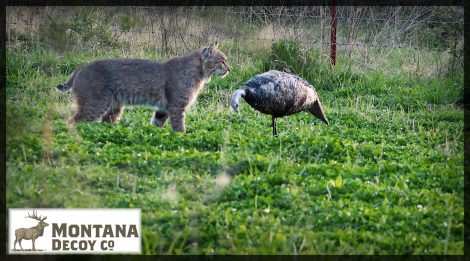 Short VIDEO:
Short VIDEO:
This bobcat has to get up-close to figure out if this is a real turkey or not! He gives this Montana Decoy a good sniff to make his decision!
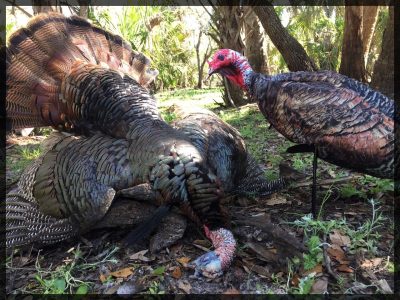
Tip of the Week:
A jake decoy can be a very effective tool during early breeding season while toms still sort out dominance.
Turkey Hunting: 7 Important Tips for Patterning Your Shotgun
We’ve been preparing for turkey season – practicing our calls, doing a lot of prescribed fire and getting our decoys ready.
In addition to scouting and practicing turkey calls, this is the time of year to make sure and spend some time patterning your turkey gun. In my opinion, this is the most important thing to do before a hunt. (I recently patterned the 12 gauge before our Florida turkey hunt.)
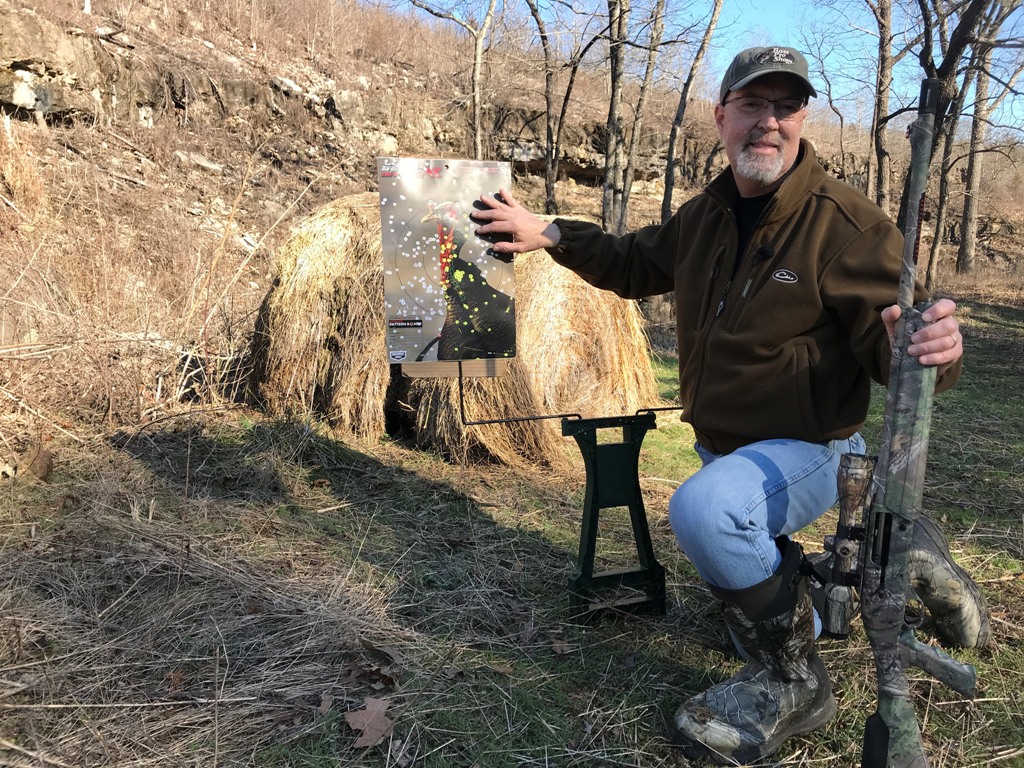
Here are a few tips to consider when you are patterning your shotgun:
-
- The most important aspect to remember when you head to the range is to grab your hearing protection. Always, always protect your hearing when shooting or when around loud equipment. Good hearing is vital to turkey hunting and enjoying Creation.*
- While this seems obvious, it needs to be said: shoot the same shell that you’ll be using when turkey hunting. Don’t go the cheap route and use an off brand when testing your gun. Know how both your gun and the load perform together.
- Since you are testing the accuracy of the gun, take out the other sources of error. Use a gun rest or shooting bench, shoot from a seated position and measure the guns performance, not yours. You can go to a shooting range or do what I do and use a Lead Sled and Stable Table from Caldwell Shooting Supplies.
- Test the gun at different yardages. Notice how the pattern changes as the distance increases because when you are in the field that tom might hold up at 40+ yards or surprise you and come in really, really close! Making a kill with a turkey gun can be easier at 30 yards than 10 yards. This is because the shot pattern of a turkey gun is smallest at close range. It would be much easier to miss a tom at 10 yards, due to the very tight pattern, than at 30+ yards.
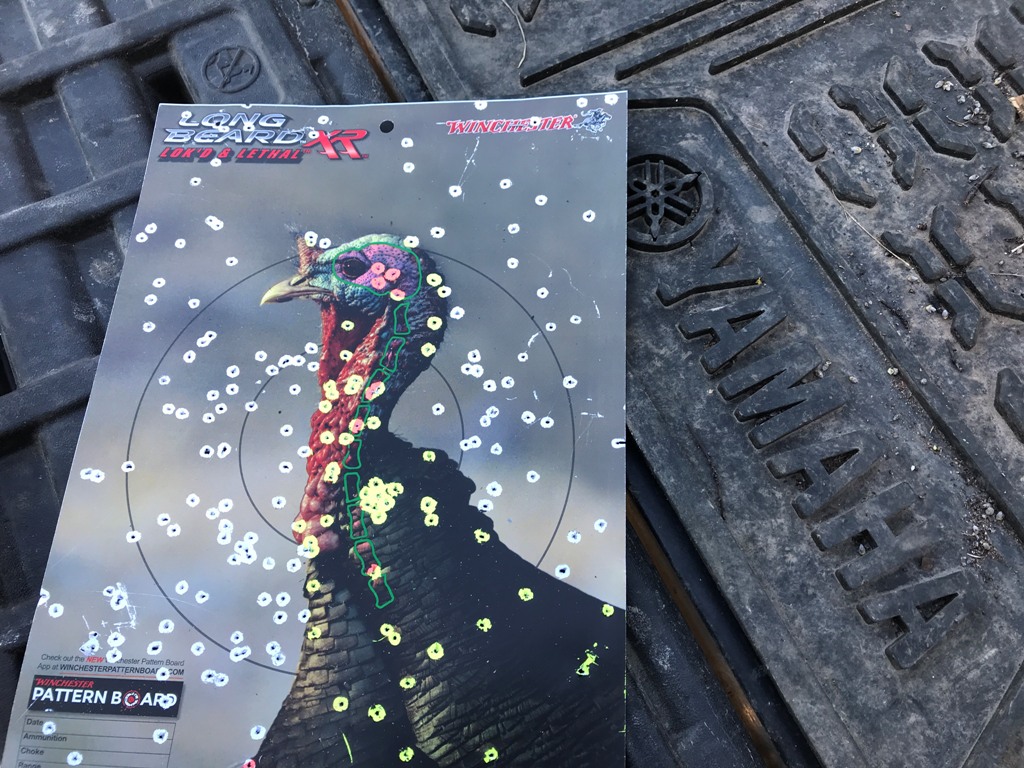
- Before you go to the range, check out this handy tool that I use: the Winchester Pattern Board Application on Winchester.com.
- What gauge shotgun will you be using? Consider the weight of your gear if you’re running and gunning. I have found that by carrying the light and collapsible Montana Decoys and switching to a 20 gauge, it’s a lot lighter when you’re standing on one ridge and that tom fires off on the other ridge. Winchester now has a 20 gauge in Long Beard XR. I love the idea of toting a 20 gauge over these Ozark Mountains.
- Think about the benefits of using a scope on your shotgun. If you’ve ever shot the Long Beard XR shells from Winchester, you know how tight they pattern. And if you’ve got a bird at 20 or 30 yards or even 15 yards, you could miss easily if you’re just using a bead. And if you’re at 40 yards, you want to make sure the gun’s bead isn’t covering the entire tom. Plus, a scope keeps your head down and you know exactly where your point of aim is going.
Many of our friends across the southern portion of the US are already out in the turkey woods. We’ll be doing the same soon as we travel to hunt in Tennessee!
When you’re out there – remember to take time, look around and thank the Creator for all His blessings and the ability to live in a country where we have the freedom to hunt.
Enjoy Creation,
Grant
*When I’m hunting I wear WildEar hearing protection. These have been great to wear in the field. Small and custom fit that protect your ears from extreme noise and gun blasts that also provide hearing enhancement. I’ve lost hearing from years of shooting without protection. The WildEar helps me to hear turkeys and other sounds in the woods that I cannot hear with my natural hearing.
Turkey and Hog Combo: Opening Day Success in South Florida – Episode #433
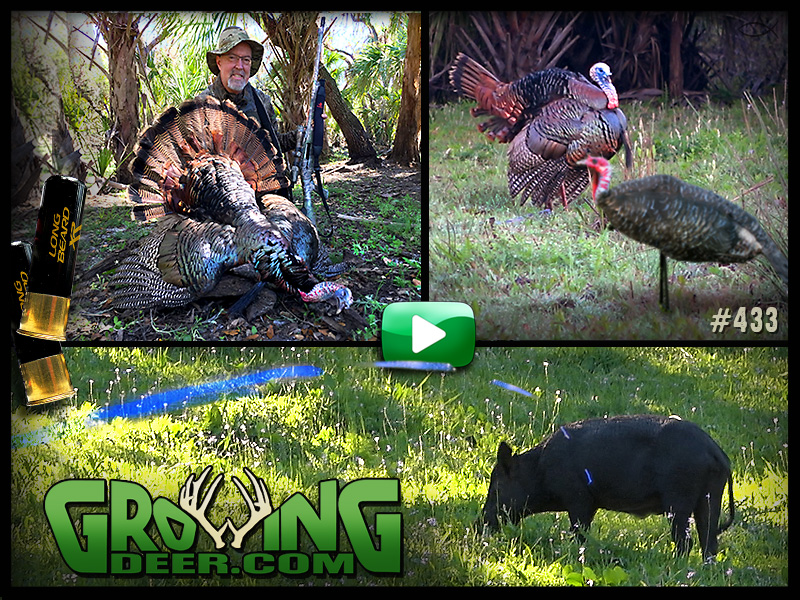 New Video
New Video
Grant and Clay head to south Florida to kick off the 2018 turkey season! It’s early in the breeding season and Grant has to switch his hunting tactics to bring a longbeard into range. Plus, Grant stalks a sounder of hogs to bring home fresh pork!
spring field days 2018:
Learn how to improve the habitat and hunting on your hunting grounds March 23rd and 24th at Spring Field Days! Registration is limited to 100 participants. Register now as there are only a few spots still available.
new weekly blog:
For those turkey hunts that don’t go quite as planned or toms just go silent one of the best tools to locate a gobbler is a crow call. Find out how a crow call can be an effective call in your turkey vest!
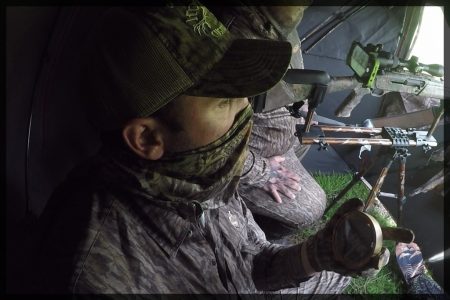 Short VIDEO:
Short VIDEO:
This video will get you fired up to practice your calling! Turkey calling in action and getting results. Watch this turkey calling sizzle reel!
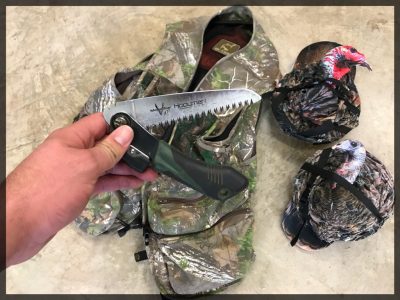
Tip of the Week:
Having a small saw or pruner in your turkey vest is great for clearing shooting lanes on the go!
Turkey Hunting: Favorite Locator Call #2 | The Crow Call
Last week we shared turkey hunting tips for locating turkeys with an owl call. The owl call is the first call out of our vests when we hit the turkey woods. As we go through the day, other calls start to come out to call in or locate those toms.
World Champion Caller James Harrison has some advice for those turkey hunts that don’t go quite as planned, when the toms went the other way or just go totally silent. In these type of hunting situations he considers one of the best tools to use to locate more gobblers a crow call.
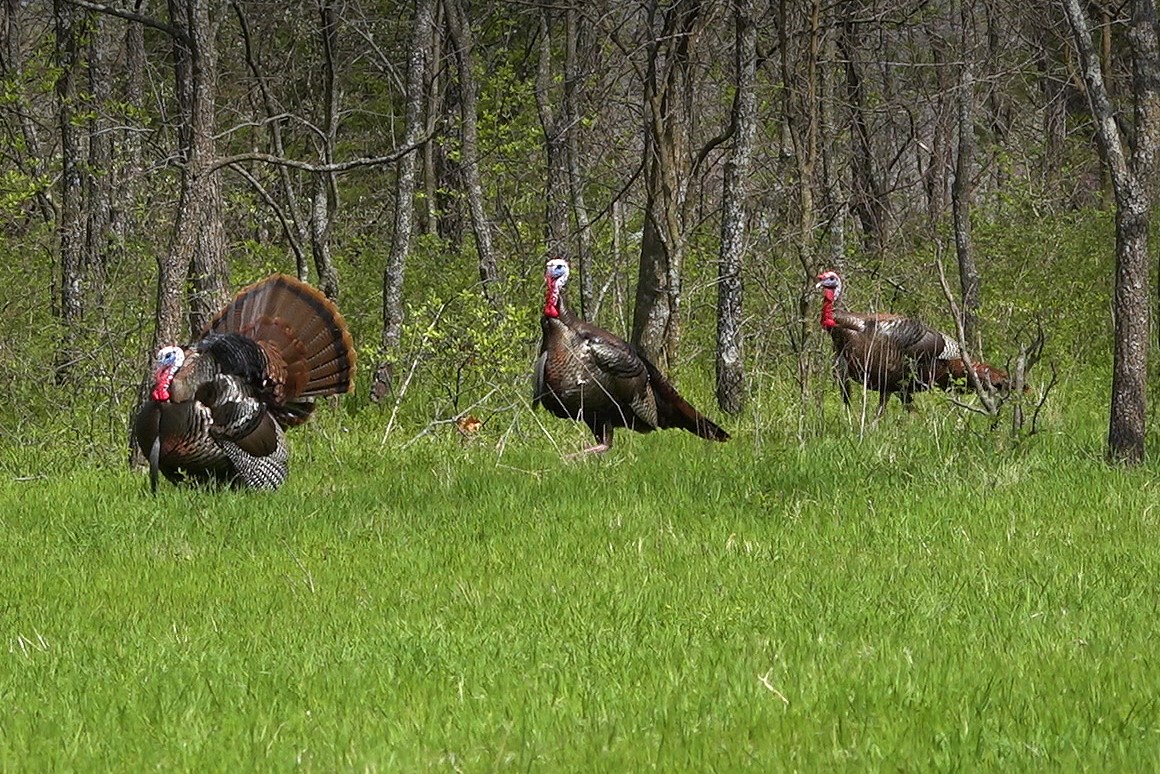
Crow calls are louder, sharper and will get the toms to gobble. It is one of James’ favorite tools to get turkeys gobbling.
In the early morning hours, if you’ve tried an owl call without response from the turkeys, James suggest changing things up. You can even use them right off the roost if you’ve got a lot of owls in your area. If the owls are hooting and the turkeys aren’t gobbling, make a crow call.
He definitely recommends using a crow call from midday on.
For those states that allow all day hunting, they are especially good for the afternoon and early evening before the birds go on the roost.
If you’re hunting with a partner have them step away from you (the caller) so that they can listen for the tom’s response to the call (just like with the owl call) as crow calls are extremely loud.
James recommends crow calls with a sequence of three to four short bursts, varied in length. Listen. Repeat.
If you’re “tuned up” you can get crows to respond back and actually call in crows! When another crow responds back, he’s actually locating the turkeys for you!
The more realistic you can be with your crow call the better off you’re going to be when turkey hunting! Locator calls like the owl call and the crow call can be practiced outside without educating the turkeys in your area as you “learn” the calls. So while you’re sitting on the porch, checking trail cameras, fishing at the pond, shed hunting, or just doing yard work – take your crow call along and get some practice in!
A special thank you to James for these helpful tips! We hope they will bring you success this year on your next turkey hunt!
Enjoy Creation,
Tracy Woods
Turkey Hunting: Using an Owl Call
What’s the first call to come out of your turkey vest?
To locate gobblers early in the morning one of the best calls to use is an owl call. It’s one of the best calls to get turkeys to sound off on the roost. (You’ll see Daniel and Clay using an owl call in this turkey hunt linked here.)
After talking with world champion caller James Harrison, I’ve put together a few basic tips for using an owl call. James Harrison is the mastermind and creator of the Harrison Hootin’ Stick by Hook’s Custom Calls.
If you are hunting in hardwoods, it’s important to not call too loudly at first. Owls are naturally only so loud. If a turkey is nearby and you over blow, you’ll scare the tom into not gobbling. It’s best to ease into the call. A modest, softer first “hoot” is best. If all is silent, you can begin to crank up the volume.
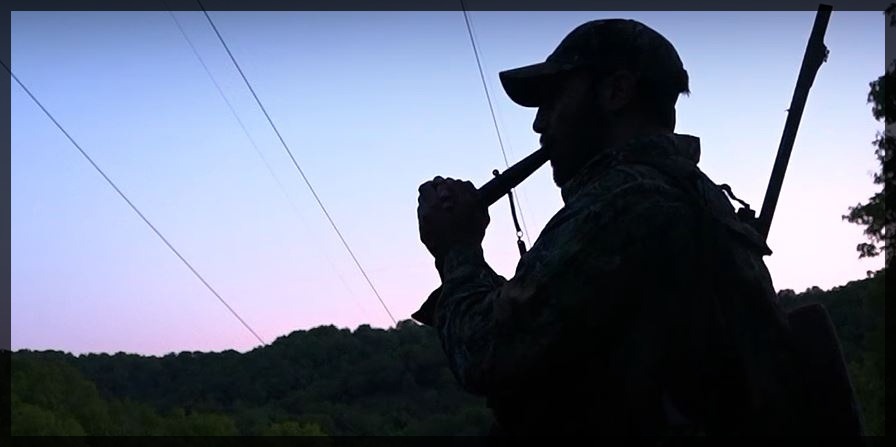
If you are hunting with a partner, send them a short distance from you (the caller). That way your partner can listen to see if there is any response to your calls. As the caller, you will have the sound of the call in your ears and may not hear a tom answer.
If you are in open country, try holding the call at the end, grasping it with your thumb and index finger, making an “okay” sign with the end of the call in the middle. Then cup the other fingers to make an open “tube” on the call. This will help you get a little more range out of the call. The pitch is higher and carries a little further to get distant turkeys to gobble.
The more realistic you can make your calls the better off you are. It’s safe to practice owl hooting in the pre-season. Break out the calls, step outside and work on those hoots!
(To see how to use an owl call visit Hook’s Custom Calls to see the “how to” videos on their page.)
Enjoy Creation,
Tracy Woods for the GrowingDeer Team
Turkey Hunting Tips: How to Use a Pot Call
Do you use a pot call? As we gear up for spring turkey hunting, the GrowingDeer Team will have calls in hand (and mouth) to fine tune calling skills.
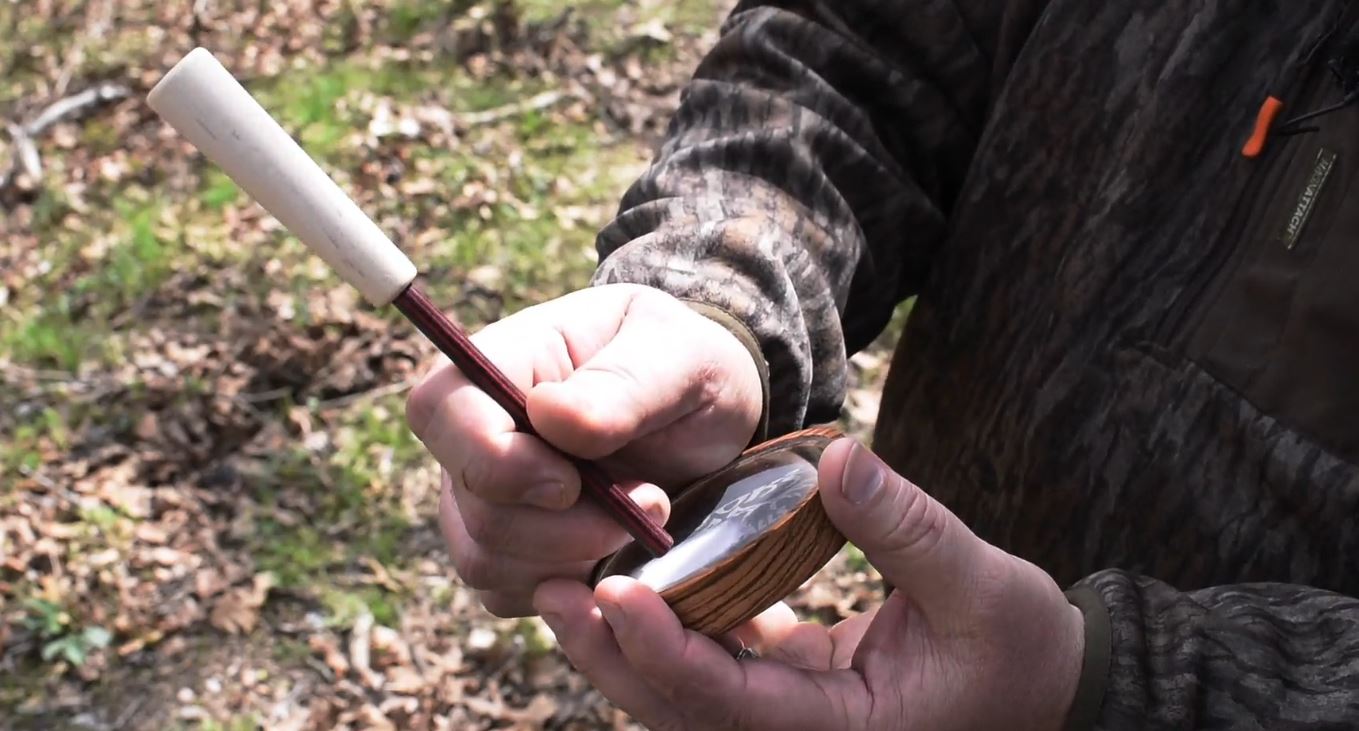
With the help of World Champion Steve Morgenstern we’ve created several tips on how to effectively use a pot call for turkey hunting:
- Grip: Grip is everything. Grip the pot with your fingertips. Do not let it set flush with the palm. That deadens the sound. Keep your fingers extended with open space under the call. This creates a sound chamber and helps the call carry and sound real.
- Striker position: Rest your hand on the side of the pot. Hold the striker about an inch up from the tip of the peg. Tilt the striker peg slightly so that it will bite the surface of the call. Where you hold the peg determines the sound produced. Play with where you grip/hold the striker. Gripping the striker peg further down will give you a different pitch. Experiment to find the “sweet spot”, which makes the most realistic sound.
- Cluck: A simple, short, quick, straight rub of the striker against the surface. A slight snap often helps.
- Yelp: A Yelp is going to be your basic call. The yelp is a two note sound. You’ve got a high note at the top, a low note coming down. Move the striker in a curving motion (think oval shape, fish hook, or J shape) to get high and low notes. Then develop a rhythm as you put them together.
- Purr: Lightly drag the striker across the surface, allowing it to skip slightly. It’s a softer call so keep it light and slow.
Thanks to Steve for these simple tips! Stay tuned! We’ll be sharing more expert tips to improve your turkey calling over the next few weeks as we gear up for turkey season!
Enjoy creation,
Tracy
Double Down In Kansas – Episode #391
New Video
In this video Heath Martin punches his final Kansas turkey tag then passes the Winchester to his wife Lindsey! Plus, watch as we fire up the Genesis drill and roll into planting season!
 Short Clip:
Short Clip:
Turkey season is winding down and we are thinking about
fall! Watch Grant share one of his favorite practice techniques to prepare for bow hunting whitetails!
New Weekly Blog:
Watch out for ticks this summer! If you are going to be in the woods, treat your clothes now so you can enjoy a tick free summer!
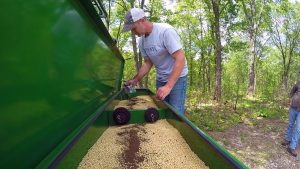
Tip of the Week:
Inoculating soybeans helps fix nitrogen in the soil. For the best inoculant results, store inoculant in cool, shady places so the helpful bacteria that fixes nitrogen can live!
Searching For Turkeys And Better Food Plots! – Episode #390
New Video
Watch as Daniel hunts a quiet, late season tom! Not only is there success in the turkey woods, but find out how the Steel Buffalo (roller crimper) can help lead to food plot success!
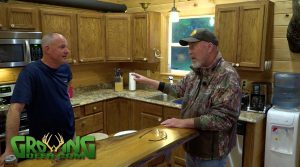 Short Clip:
Short Clip:
See why Grant recommends land mangers use high quality food plots during the summer months instead of relying only on native browse.
New Weekly Blog:
Find out how you can replicate the natural process that helped build the soil of the great prairie to improve your food plots.
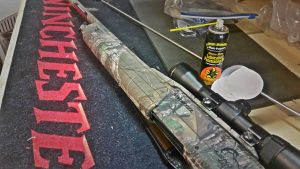
Tip of the Week:
Turkey guns usually see dirt, rain, and other conditions that are harmful to a gun. Cleaning your turkey gun after season is a great way to extend the gun’s life and prepare for next season.



